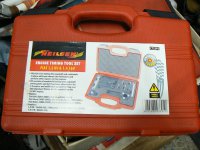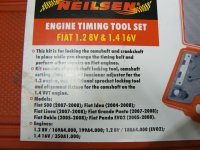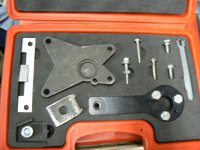First off, buy the Haynes manual - Manual No 5558 - and make friends with the good people at Shop4parts:
https://www.shop4parts.co.uk/ They are very knowledgeable indeed and also friendly and not at all pushy. I've bought quite a bit of stuff from them over the years and never had a wrong part supplied yet. Some unusual brands because they source direct from Italy, but all good quality stuff.
Next, regarding those engine numbers. According to Mr Haynes, up to engine number 2533527 the engine will have a timing mark on the top, camshaft, pulley as well as on the crankshaft pulley. From 2533528 the cam pulley, which is still a solid metal pulley, lost it's timing mark. So there is no reference mark for timing purposes and you'll need the timing tool set to do the job unless you take a chance and do it by the "tippex" method. My 1.2 has this type of pulley so I bought this set of tools off ebay which has worked splendidly and wasn't a lot of money:
View attachment 422460
View attachment 422461
View attachment 422462
If you decide to just mark everything up, transfer the marks to the new belt and reassemble - the afore mentioned "tippex" method - you need to be very sure the timing is correct - or that it's the first belt change since it left the factory when you can be pretty sure the timing will be correct. If you're sitting scratching your head wondering what I mean then you need to know that on engines with no timing mark on the top pulley, the pulley and camshaft are not keyed! The official procedure for fitting and timing a new belt involves slackening that top cam pulley retaining bolt, just slightly so the pulley can spin on the shaft. Then, with all the locking tools fitted, so crank and cam both locked, the new belt is fitted and tensioned then the big cam pulley bolt is retightened. If this is done incorrectly the timing will be "off" and you can't check this without the timing tools. So, if the engine is unknown to you, you can't be sure this will have been done correctly without the timing tools to check. There's loads on the forum about timing up these engines, have a search around and see what you can find. There's a definitive guide in the guides section of the grande Punto section
So first thing you need to do is take the wee top belt cover off and look at the front outer rim of the cam pulley. At the age your car is I suspect you'll have the one that's marked. This means the pulley is keyed to the shaft and the engine is timed by lining up the crankshaft pulley mark with it's corresponding mark on the oil pump casing and camshaft pulley mark with it's mark on the head, fit the belt, tension it - if you're used to doing it by the quarter turn method that works as well as any - Turn the engine over a couple of revs to check the valves and pistons aren't getting "chummy" and you're done.
Later engines, like mine, have a spring loaded automatic tensioner which is just "wound up" with a pair of circlip pliers - or the proper tool if you have one - until two pointers overlap. But i suspect your's will have the older "solid" type which you just twist until the belt feels "right" and then lock off with it's locking nut.
Much later on, 2012? they introduced a VVT camshaft pulley - my boy's Punto has one - which is slightly daunting if you've never done one, but actually, in the event, is no more difficult to do than the solid pulley (although you have to take a plug out of the front of it to get at it's retaining nut so you need a nice big bit of rag to catch the oil spill. Your's isn't going to be one of these though so we can forget them for now.
So your first thing to do is whip that top cover off and see if the top pulley has a timing mark on it. If it does, oh happy days, no timing tools needed, all very simple. Here's the link to Andy's guide:
https://www.fiatforum.com/guides/1-2-8v-evo-2-engine-cam-belt-replacement.732/ Much of which applies to all FIRE engines.
Hope that's a help. These engines aren't too bad to work on. getting the bolt out of the bottom of the engine mount is slightly difficult due to access but once you've undone the mount to wing bolts you can gently lever the engine over to the N/S a little to give more clearance. Block of wood and jack under the sump to take the weight. But look carefully at the sump first as at this age it's very likely to be seriously rusted and weakened, unless someone has fitted a new one.
Do let us know how it all goes. and feel free to ask more questions if you need to





